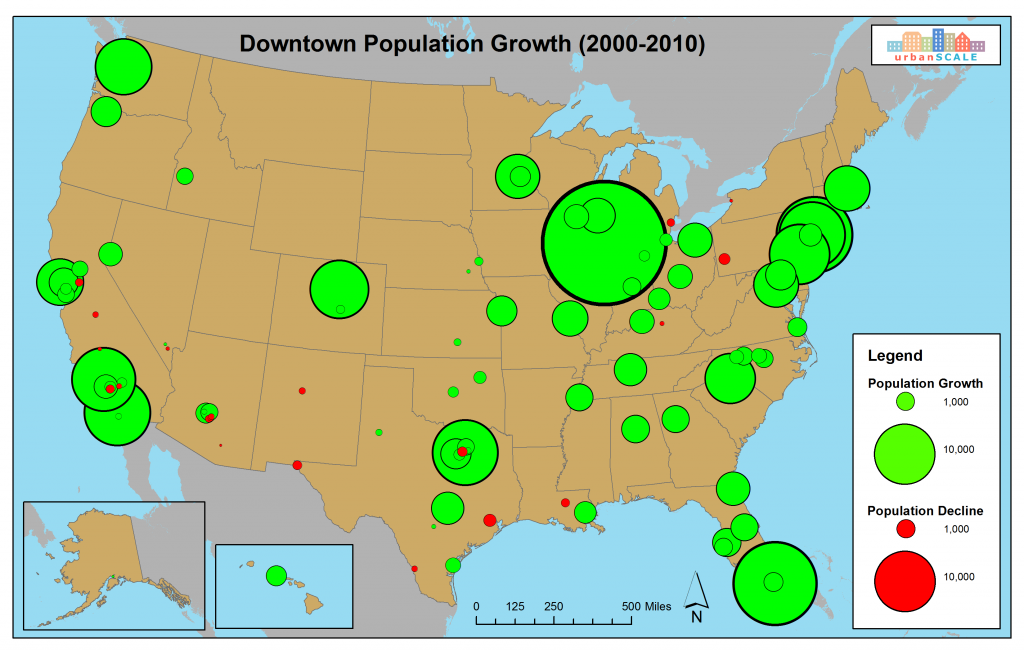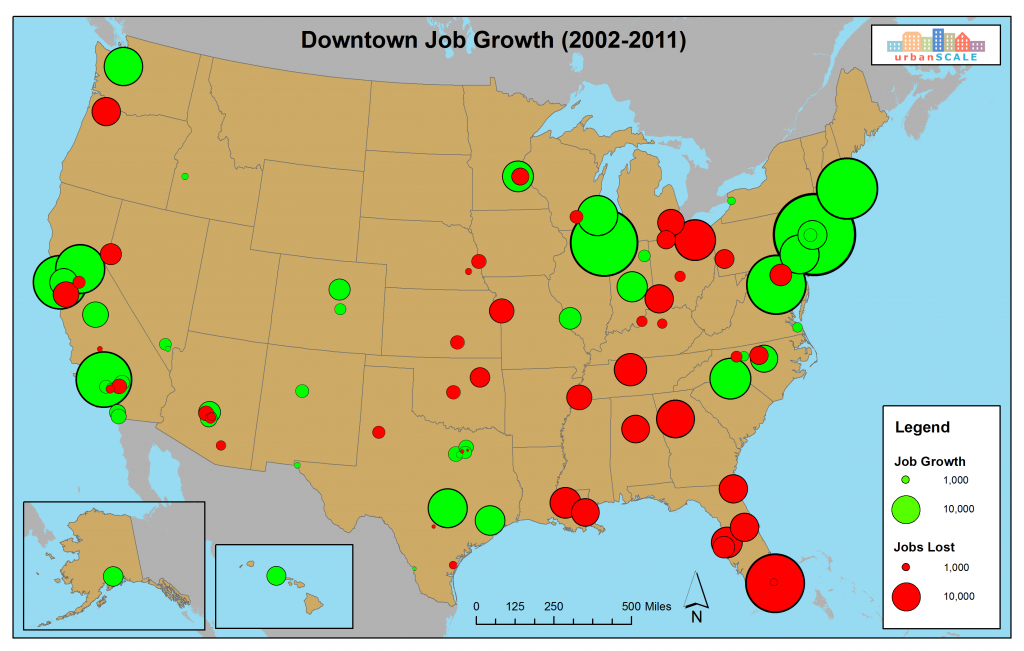This is the second in a series of three entries on thriving downtowns in the largest 100 U.S. cities. The first post focused on growth rates of downtown population and jobs. This post also looks at the growth of downtown jobs and population in each city, but focuses on absolute numbers instead of percentages. The third post looks at each downtown’s importance to its respective urban region.
In Part 1 of this series we established the fact that, over the last decade, downtown revitalization is a national trend. The majority (about 80%) of downtowns in the largest 100 U.S. cities are gaining residents. If you still have any doubts about the recent success of the nation’s largest downtowns, this blog post will lay those doubts to rest.
We measure six variables for each of the 100 largest U.S. cities* in this post:
- Job Growth in CBD (2002-2011)
- Job Growth in CBD + 1-Mile Radius (2002-2011)
- Job Growth in CBD + 3-Mile Radius (2002-2011)
- Population Growth in CBD (2000-2010)
- Population Growth in CBD + 1-Mile Radius (2000-2010)
- Population Growth in CBD + 3-Mile Radius (2000-2010)
As the saying goes…a picture is worth 1,000 words. So, let’s start off with a map (for those that want the hard numbers of downtown population growth and job growth for each city, please see the table at the end of this post). The green circles on the map are cities that have gained downtown residents since 2000 and the red circles are cities that have lost downtown residents in the last decade. The size of the circle represents the amount of population growth (for green circles) or population decline (for red circles). Here’s the map:

Woah! That’s a lot of green! The nation’s downtowns have really grown over the last decade. In fact, more than 250,000 net new residents moved into the downtowns of the 100 largest U.S. cities from 2000 to 2010. Clearly, this is a big win for U.S. cities in their quest to become more vibrant. Now let’s take a look at downtown job growth.

Okay, not as impressive as downtown population growth. There is a lot of green on the map, but also a significant amount of red…Now might be a good time to mention that a net total of 175,000 new downtown jobs were added in the nation’s 100 largest cities from 2000 to 2010. And keep in mind that this took place during a decade that included the worst economic recession since the 1930s!
The Great News
If anyone tries to tell you that downtowns are declining in general, they are wrong. Sure, there are many cities that have struggled with downtown revitalization for decades. And a handful of cities are still experiencing substantial declines in the employment base in their CBD. But, as I noted in Part 1 of this blog post series, the thing that most downtowns are lacking is residents, not jobs. And population growth is a near universal trend across the entire country. Even where there have been declines in downtown residents, these declines pale in comparison to the population increases experienced in the downtowns of many cities.
The REALLY Great News
This is just the tip of the iceberg. Downtowns are poised for much more growth in the coming years and decades. Numerous factors are converging (young people driving less, increasing traffic congestion in large cities, Baby Boomers retiring and moving to more walkable environments, rising costs and environmental consequences of suburban lifestyles, among many others) that will only accelerate the growth in population and jobs across America’s downtowns. One of the biggest trends that is already having a big impact on downtown population growth is the fact that young adults are less interested in driving and car culture than previous generations (read more here in an article from the Atlantic Cities by Richard Florida). Moreover, the maps above only show the growth in the CBDs of each city, not for the close-in neighborhoods that surround each downtown. If you look closely at some of the data in the table below, you’ll see that many cities experienced declines in population in their greater downtown area (the CBD + 1-Mile Radius zone and the CBD + 3-Mile Radius zone) yet gained residents in their CBD. This is the canary in the coalmine. Downtown population growth is a harbinger of a more vibrant urban future for many cities. People are “voting with their feet” by making the deliberate decision to move into downtowns in cities across the U.S. Even in cities that have experienced declines in their population for several decades – places like Cleveland, OH, Birminghan, AL, and Milwaukee, WI – people are moving into downtown by the thousands. This is an undeniably positive trend that will help revitalize the downtowns of these cities, spreading into the surrounding urban core, and over time, the growth in these downtowns will improve the vitality of the entire city and urban region.
Stay tuned for Part 3 of this series, which will highlight how important each downtown is to its respective regional economy.
Downtown Population and Job Growth in 100 Largest U.S. Cities*

*This blog post is focused on 95 of the 100 largest U.S. cities because 5 of the 100 largest cities (Virginia Beach, VA; Aurora, CO; Irvine, CA; Chesapeake, VA; and North Las Vegas, NV) do not have recognized downtown districts.




Hi John
Great job. I wonder what is the breakdown for in state movers as opposed to out of state.